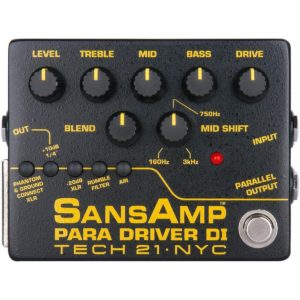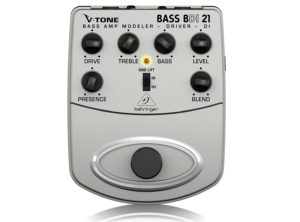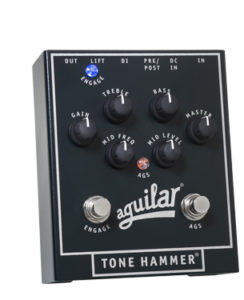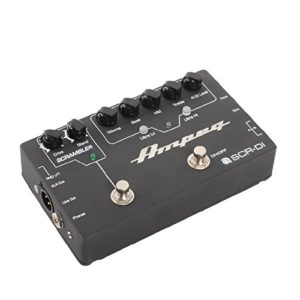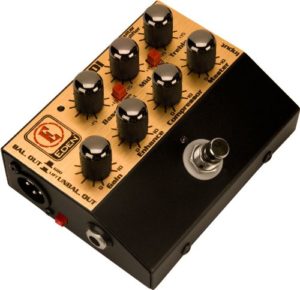Are you looking for the best bass preamp pedal? Then, you’re in the right place!
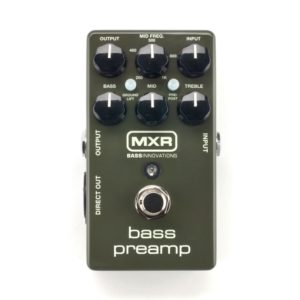
If you use your preamp/DI box primarily on stage, look closely at the various units’ physical construction and durability. Musicians love to call their pedals “stompboxes,” and for a good reason.
If you are a studio musician who sets the box and doesn’t make changes on the fly, you can take a slightly different view when you do your shopping.
Without further ado, take a closer look at our list, and then you can make a more informed decision about which direct preamp box should be part of your equipment inventory.
The 6 Best Bass Preamp Pedals
MXR M81 Bass Preamp (Editor’s Choice)
With the MXR M81 Bass Preamp, you can dial in almost any tone you want, pre-EQ or post-EQ. In addition, players who use multiple pedals will like the box’s narrow design, giving you pedalboard space for other units if you need them.
Main control knobs include Input, Output, and Mid-frequency, in addition to Bass, Mid, and Treble, which gives you plenty of flexibility. The MXR also has a “studio-quality” Direct Out.
The unit also has a Ground Lift switch to handle loop hum. Internal switches can disable the Direct Out and ¼” out buffered bypass for “a true ¼” out bypass mode.”
MXR has been producing popular effects pedal products for half a century and always seems to lead to innovation. The products are now produced in California by Dunlop Manufacturing.
Pros
- Sweepable mid-range frequencies
- Quiet, clean
- True bypass capability
Cons
- Possible EQ limitations
- Better for slap bass
Tech 21 SansAmp Para Driver V2 DI
When you connect the Tech 21 SansAmp Para Driver V2 DI, you’re putting active tone controls in action, with 12 dB of cut or boost and sweepable “semi-parametric” EQ. In addition, you’ll have the control to produce an unaffected output for a dry signal to a separate channel.
There are plenty of control options, with Level, Treble, Mid, Bass, Drive, Blend, and Mid Shift. In addition, you’ll find amp simulation more than sufficient for almost every situation.
But there are smaller buttons for Phantom and Ground Connect XLR, +10dB ¼” and -20dB XLR. The Rumble Filter switch removes sub-sonic frequencies that can cause your sound to “boom.”
You can also try the “Air” switch for more top-end. The SansAmp circuitry is also designed to eliminate the “harsh harmonics” of piezo pickups. Optional power supply.
Pros
- Sweepable mid-range frequencies
- The added depth of bass tone
- Phantom power capability
Cons
- Possible issues with on/off switch
- Amp simulation may be insufficient
Behringer V-Tone Bdi21 Bass Amp Modeler / Direct Recording Preamp / Di Box
The Behringer preamp/DI box has a slightly different look and design than the other units reviewed here – shape, color, knob design. But it is pretty flexible from the standpoint of producing tones, from traditional bass amp sounds to some of the more “modern” sounds.
Presence control is more than adequate, though it only has a two-band EQ. Standard operation is with one nine-volt battery. The power supply is optional.
The company promotes its “tube emulation” circuitry for added blend and the dual DI modes for direct recording output or standard active DI in bypass mode. The unit also has Ground Lift switch for those typical loop issues.
Pros
- Price vs. performance
- The true bass sound in bypass mode
- Suitable for average/starter players because of price
Cons
- Plastic upper case
- Circuitry quit after a few months
- Not durable
Aguilar Tone Hammer Bass Preamp Direct Box
The company has given this unit the name “Tone Hammer” because the results are powerful. As mentioned in the general discussion earlier, you not only have reliable DI results, you also get a full sweep of mid-range frequencies, as well as treble control and bass control.
One of the “discussions” on direct-box use centers around whether they’re best for studio or live use. This one gives you flexibility thanks to its tone-shaping capabilities.
The Aguilar Tone Hammer Bass Preamp Direct Box uses “proprietary” Adaptive Gain Shaping, so you can have added gain and equalization using your foot on the AGS button to the right. This unit also gives you separate Gain and Master for added control.
You have pre/post-DI output and ground lift switch as well. Operates on two nine-volt batteries or an optional universal power supply. The Tone Hammer comes with a three-year limited warranty.
Pros
- Sweepable mid-range frequencies
- Flexible gain can drive power amp
- Switchable pre/post EQ balanced output
Cons
- Slight lack of depth
- Sufficient power with batteries
Ampeg SCRDI Bass DI Preamp
Some bassists will be drawn to this unit because of the Ampeg name, popular among players for years. It delivers the “classic” preamp you’d expect from the company, along with EQ and overdrive control in a rugged design.
You can send a split signal for monitor/amp usage and use it for practice with a 1/8” aux input for use with your music player.
Players will like the Bass Scrambler Overdrive circuit and the grit of the classic SVT sound. This circuit has separate Drive and Blend control knobs.
You’ll have the traditional Ampeg tone you need and desire, along with the well-known Ultra-Hi and Ultra-Lo circuits for added tone shaping. Musicians will also like the overall fit and finish of the Ampeg SCRDI Bass DI Preamp.
Pros
- It’s an Ampeg
- Warm tone
- Overdrive
Cons
- Noise with a few specific units – circuitry?
- Sensitivity hard to control – input control
Eden World Tour Direct Box Preamp Pedal
As is the case with many new units, the Eden World Tour Direct Box Preamp Pedal is “more than a direct box.” You get true preamp control and performance on stage and in the studio, with true bypass, three-band tone control, Bass Boost, variable compression, and mid-shift switches.
The tone is clean, and the low-end performance is easy to manage. On-stage players will like the design, which puts the “stomp” switch at a slight angle, with the seven control knobs and finger switches on a flat top.
The top row of knobs has Bass, Mid, and Treble, with Gain, Enhance, Compressor, and Master on the bottom row. You’ll get plenty of tone control to produce a thickness and punch.
Tremendous boost is one of the key elements making this unit stand out. After you tune it in during the first session or two, you’ll have what you need to produce a solid bass foundation.
Pros
- The physical layout of knobs and footswitch
- Ability to dial in texture
- Beefy bass
Cons
- Power light too bright makes it hard to see on stage
- Circuitry failure with a limited number of units
Buyer’s Guide: How to Find the Best Bass Preamp Pedal
Before deciding which preamp direct box is suitable for your music, you should make sure you understand what this technology can and cannot do for low-end sound. Using a direct box is quite convenient for the soundman and the bassist to a lesser extent. But this applies to the set-up most of all and the control both have over the output.
But what does it do to the sound, and for the sound? That is the heart of the matter.
If you do some brief research on this subject, you’ll come across terms such as “direct input,” “direct injection,” and “direct interface.”
Don’t dig so deeply into this and get so confused you don’t focus on the sound you’re trying to produce. Instead, you can simplify things by concentrating on the sound you’ll get in a studio and the sound you’ll get when playing live, on a stage, or in a club.
It would be best if you first were interested in knowing what a direct box does for your sound. Only you, your fellow musicians, the soundman, and your audience know this.
Unless you’re a master technician and a master bassist, you can leave the engineers’ real technical stuff. Books are written on the subject of producing the best, low-frequency sounds, but you might want to leave that for your college education.
Then and Now
A few decades ago, a direct box was just that, another connection between the bass and final sound through the amp, the main speakers, etc. The idea was to reduce noise levels – buzz, hum – when a musician boosted the guitar’s signal level.
Low-level signals are susceptible to noise. A direct box takes an unbalanced signal from the bass and converts it to a balanced audio signal.
That converts the signal from the unbalanced guitar cord to a balanced signal from the XLR cable coming out. So the bottom line is that you reduce or eliminate line noise and control the bass tone when it goes into the mixer.
It’s a Preamp and a DI Box
New products produce this same result but add other controls for enhancing the final sound. Enter the direct preamp box. A preamp must increase your gain, change tone, convert from unbalanced to balanced, lower output impedance, or achieve a combination of these tasks.
One veteran of the bass world says that if your box has knobs and gives you a different sound, it’s a preamp. And, that’s not a bad thing.
Again, keeping the discussion in the musician realm and off the laboratory bench, you can get multiple benefits from the newest products if you use them correctly. A DI unit can be just what you need in a “bad room” when you’re playing live.
Second Look
Someone once said that when you’re presenting information to a group of people, you should tell them what you’re going to say, tell them, then tell them what you just said.
It is the best method for putting important information out, especially when it will be used to produce quality sound. So, at the expense of repeating a few key factors, here is a summary of what you’ve just seen.
Read the specs and reviews on these six preamps/DI boxes carefully, so you know what each one will deliver.
A direct box should be in the equipment bag of every bass player, but you should use it with all due consideration – when you need it! Always ask yourself what it does to your sound and what it does for your sound.
Please don’t get too caught up in the direct injection, direct input discussion, though it’s always good to be an educated consumer. Instead, try to simplify things by getting the unit that gives you what you want, not what someone tells you is best.
Only you know the answer to that. Most of the units reviewed have a three-band EQ. So why not go ahead and get one that delivers this unless your budget is severely limited?
Two in One
Returning to the idea of these products being both a preamp and a direct box, make sure you have a unit that does what a good DI box should do – reduce noise and give you balance. As for the preamp side of the issue, you will get better performance when increasing your gain and controlling your tone.
For example, the Behringer V-Tone would be excellent for practice or in-home use, as well as for studio recording when you aren’t pounding the on/off switch.
Compare that to the Eden. It has a unique design that puts the switch away from the knobs for better access, even at a slight angle.
But then there’s the Ampeg, which probably gives as good a bass tone as you’re going to get because, well, it’s an Ampeg.
In any event, you won’t go wrong with any of these units, including the SansAmp, Aguilar, and MXR. The bottom line (pun intended) is you should get what makes you sound best.
